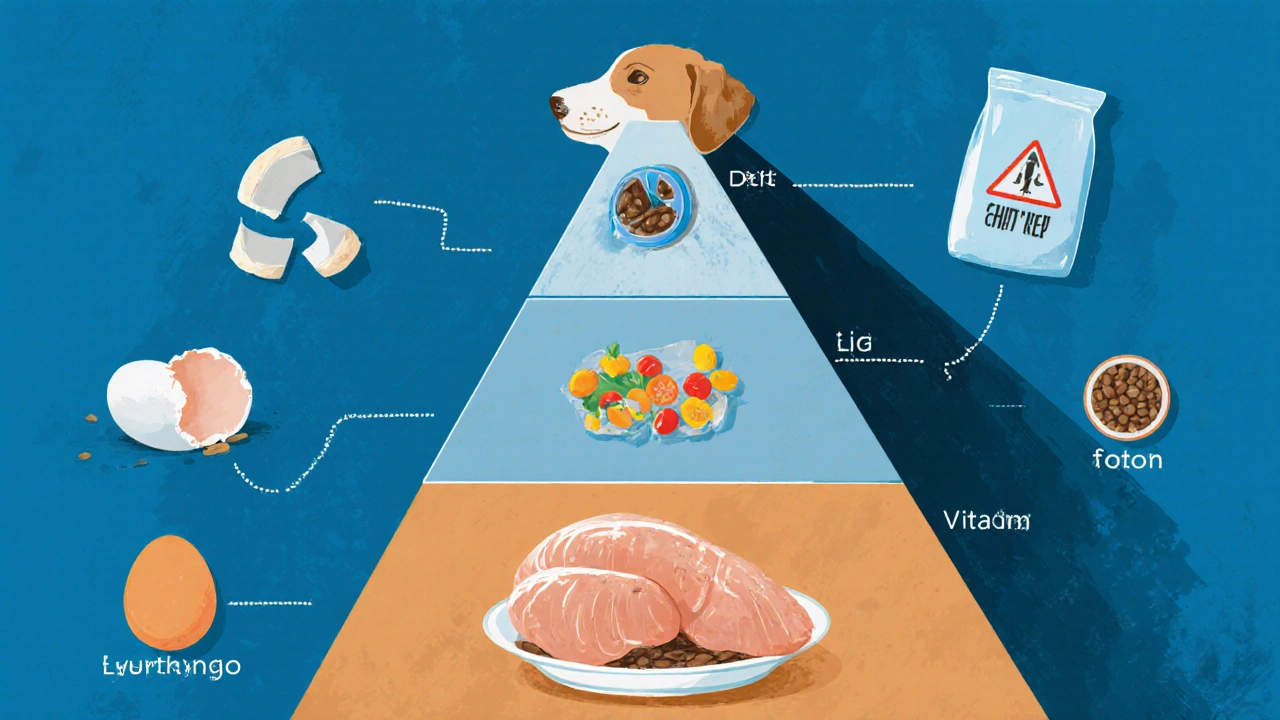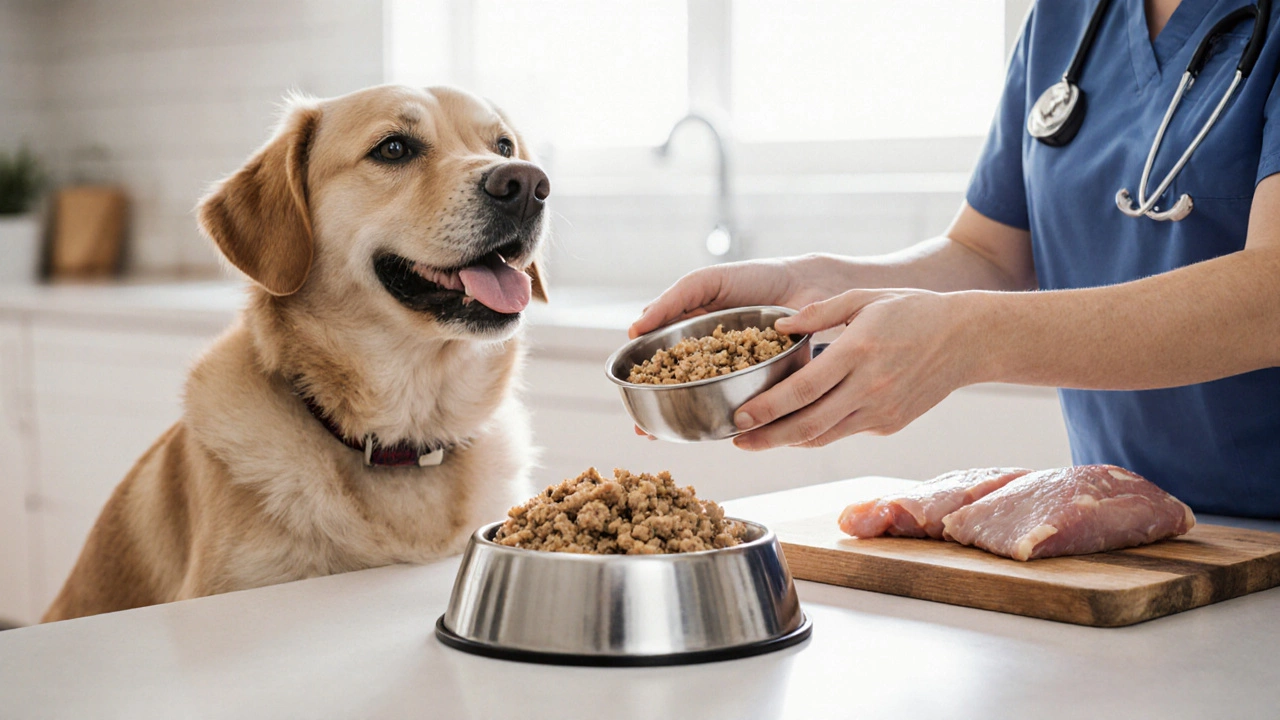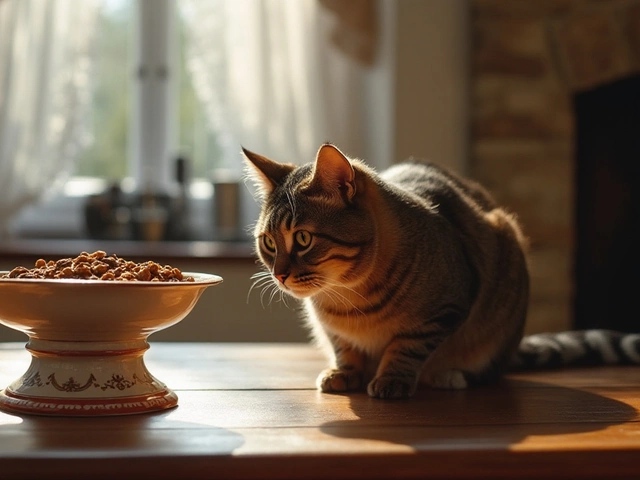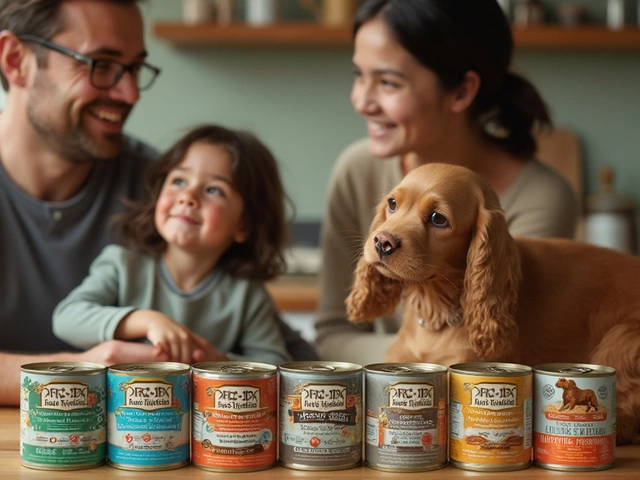Ground Chicken Portion Calculator
Dog Information
Safety Guide
Important: Ground chicken should replace 20-30% of your dog's regular food.
Always cook chicken plain (no salt, garlic, or onions). Never feed raw chicken to dogs.
Enter your dog's information above to calculate safe portion size.
Many dog owners wonder if ground chicken is a healthy choice for their pets. The short answer? Yes - but only if it’s prepared the right way. Ground chicken can be a great source of lean protein for dogs, but it’s not as simple as dumping raw meat into their bowl. Too much of it, the wrong kind, or poor handling can lead to problems. Let’s break down exactly what you need to know before adding ground chicken to your dog’s meals.
Why ground chicken is a good protein source for dogs
Dogs are omnivores with a strong biological need for animal-based protein. Ground chicken fits that need well because it’s low in fat compared to beef or pork, and it’s easy to digest. Most commercial dog foods use chicken as a primary ingredient - and for good reason. It’s one of the most commonly used proteins in vet-recommended diets because it’s affordable, widely available, and rarely triggers allergies in dogs.
Ground chicken contains all the essential amino acids dogs need to build muscle, repair tissue, and support a healthy immune system. It also provides B vitamins like niacin and B6, which help with energy metabolism. One hundred grams of cooked ground chicken (90% lean) has about 165 calories and 21 grams of protein - making it a nutrient-dense option for dogs that need to maintain a healthy weight.
Raw vs cooked: Which is safer?
This is where things get tricky. Some dog owners swear by raw diets, claiming they lead to shinier coats and cleaner teeth. Others stick to cooked meals because they’re worried about bacteria. Both sides have valid points, but the facts matter more than anecdotes.
Raw ground chicken can carry harmful bacteria like Salmonella and Campylobacter. These don’t usually make healthy adult dogs sick - their stomachs are designed to handle it - but they can make humans sick. If you have kids, elderly people, or anyone with a weak immune system in your home, raw chicken is a risk you shouldn’t take.
According to a 2023 study from the University of Bristol’s Veterinary School, 37% of raw chicken samples sold for pet consumption tested positive for pathogenic bacteria. That’s higher than the rate found in chicken meant for human consumption. So even if you buy "pet-grade" raw chicken, you’re not guaranteed safety.
Cooked ground chicken, on the other hand, eliminates that risk. Boiling or baking it without seasoning is the safest route. No oils, no garlic, no onions, no salt. Plain is best. Cooked chicken is easier to digest for puppies, seniors, and dogs with sensitive stomachs. It’s also the go-to recommendation for vets when dogs have digestive upset.
What about chicken skin and fat?
Ground chicken often includes skin and fat unless it’s labeled "lean" or "90% lean." That’s not always a bad thing - fat gives dogs energy and helps absorb fat-soluble vitamins. But too much can lead to pancreatitis, especially in breeds like Miniature Schnauzers, Cocker Spaniels, and Yorkshire Terriers.
As a rule of thumb: if you’re feeding ground chicken as a regular meal, choose 90% lean or higher. If you’re using it as a topper or treat, a small amount of fat is okay - but don’t make it a daily habit. A teaspoon of fat per 10 pounds of body weight per day is the max most vets recommend.
Chicken skin, even when cooked, is mostly fat and offers little nutritional value. It’s like giving your dog a piece of fried bacon - tasty, but not good for long-term health.

How much ground chicken should you feed?
There’s no one-size-fits-all answer, but a good starting point is to replace about 20-30% of your dog’s regular food with ground chicken. For example, if your 50-pound dog eats 2 cups of kibble a day, you could swap out half a cup of kibble and replace it with half a cup of cooked ground chicken.
Never use ground chicken as the sole source of nutrition. Dogs need more than just protein. They need calcium, phosphorus, vitamins, and fiber - things you won’t find in plain chicken meat. Feeding only chicken long-term can lead to serious deficiencies. A 2022 study from the Royal Veterinary College found that dogs fed exclusively on raw chicken developed bone density issues within 6 months.
Think of ground chicken as a supplement, not a full diet. Use it to add variety, improve appetite, or help with weight management - not to replace balanced dog food.
Signs your dog might not tolerate ground chicken
Not all dogs handle chicken well. Some have food sensitivities, even to this mild protein. Watch for these signs after feeding ground chicken:
- Itchy skin or ear infections
- Chronic diarrhea or vomiting
- Excessive gas or bloating
- Licking paws or rubbing face on the floor
If you notice any of these, stop feeding chicken and consult your vet. A food elimination trial may be needed to confirm an allergy. Most dogs can eat chicken without issue, but if your dog has a history of allergies, start with a tiny portion and wait 48 hours before giving more.

How to prepare ground chicken safely
If you’re going to feed ground chicken, do it right. Here’s a simple, vet-approved method:
- Buy fresh, high-quality ground chicken from a trusted butcher or grocery store. Avoid pre-packaged meat with additives or preservatives.
- Wash your hands, cutting board, and bowls before and after handling.
- Place the chicken in a pot with water - no oil, no seasoning.
- Bring to a boil, then simmer for 15-20 minutes until fully cooked (no pink inside).
- Drain the water and let it cool.
- Store leftovers in the fridge for up to 3 days or freeze in portions.
Never feed raw chicken bones. They can splinter and cause internal injuries. Cooked bones are even more dangerous - they become brittle and sharp.
Alternatives to ground chicken
If you’re unsure about chicken, or your dog doesn’t tolerate it well, there are other lean proteins you can try:
- Ground turkey (lean, similar to chicken)
- Lean ground beef (85% lean or higher)
- White fish like cod or haddock (low fat, great for sensitive stomachs)
- Lean lamb (good for dogs with chicken allergies)
Rotating proteins every few weeks can help prevent food sensitivities and give your dog a broader range of nutrients. Just make sure each new protein is introduced slowly over 5-7 days.
Final verdict: Is ground chicken good for dogs?
Yes - when it’s cooked, plain, lean, and part of a balanced diet. Ground chicken is a safe, affordable, and nutritious way to boost your dog’s meals. But it’s not a magic solution. It won’t fix poor-quality kibble, and it won’t replace vet-recommended diets for dogs with health conditions.
If you’re thinking of switching to a homemade diet, talk to a board-certified veterinary nutritionist first. They can help you create a complete meal plan that includes the right balance of calcium, vitamins, and minerals. Don’t guess - your dog’s long-term health depends on it.
Can I feed my dog raw ground chicken?
You can, but it’s not recommended for most households. Raw ground chicken carries a risk of bacterial contamination like Salmonella and Campylobacter. While healthy adult dogs may not get sick, they can spread these bacteria to humans - especially children, seniors, or anyone with a weak immune system. Cooking the chicken eliminates this risk and is safer overall.
Is ground chicken better than kibble?
Not necessarily. Kibble is formulated to meet all of your dog’s nutritional needs. Ground chicken alone lacks essential vitamins, minerals, and fatty acids. It’s best used as a supplement or topper to enhance your dog’s regular food - not as a replacement. If you want to feed a homemade diet, you need to balance it properly with supplements and other ingredients.
How often can I feed my dog ground chicken?
You can feed cooked ground chicken 2-3 times a week as part of a balanced diet. Don’t give it every day unless you’re following a vet-approved homemade meal plan. Too much chicken, even if it’s lean, can lead to nutrient imbalances over time. Variety is key - rotate proteins like turkey, fish, and beef to keep your dog’s diet complete.
Can puppies eat ground chicken?
Yes, but only if it’s cooked and plain. Puppies have sensitive digestive systems, so introduce ground chicken slowly. Start with a small spoonful mixed into their regular puppy food. Watch for any signs of upset stomach. Avoid raw chicken entirely for puppies - their immune systems aren’t strong enough to handle the bacteria risk.
Does ground chicken cause weight gain in dogs?
Only if you feed too much or use a high-fat version. Lean ground chicken (90% lean or higher) is actually helpful for weight management because it’s high in protein and low in carbs. But if you’re adding it on top of a full meal without reducing kibble, you’re increasing calories. Always adjust portion sizes to avoid overfeeding.







